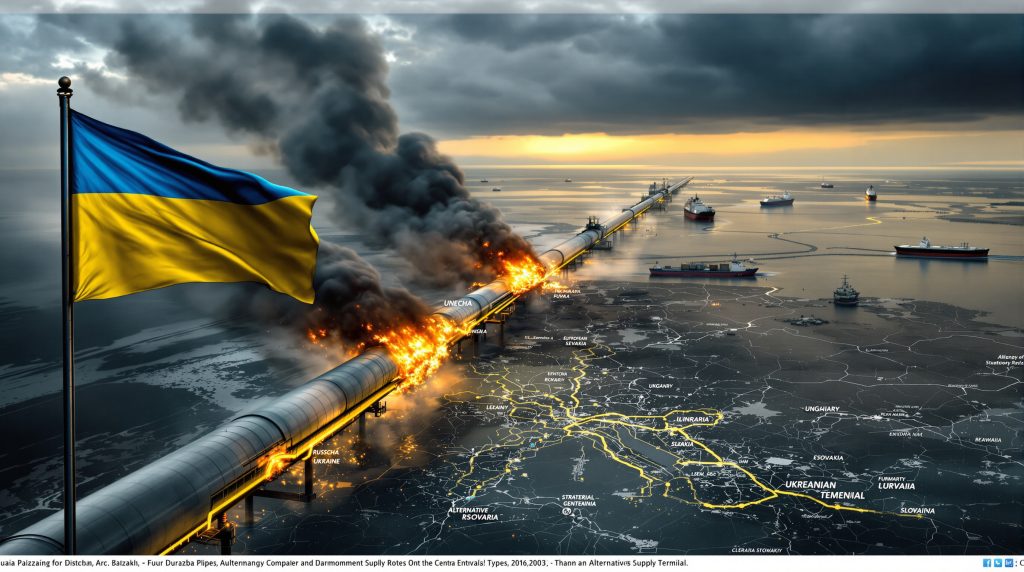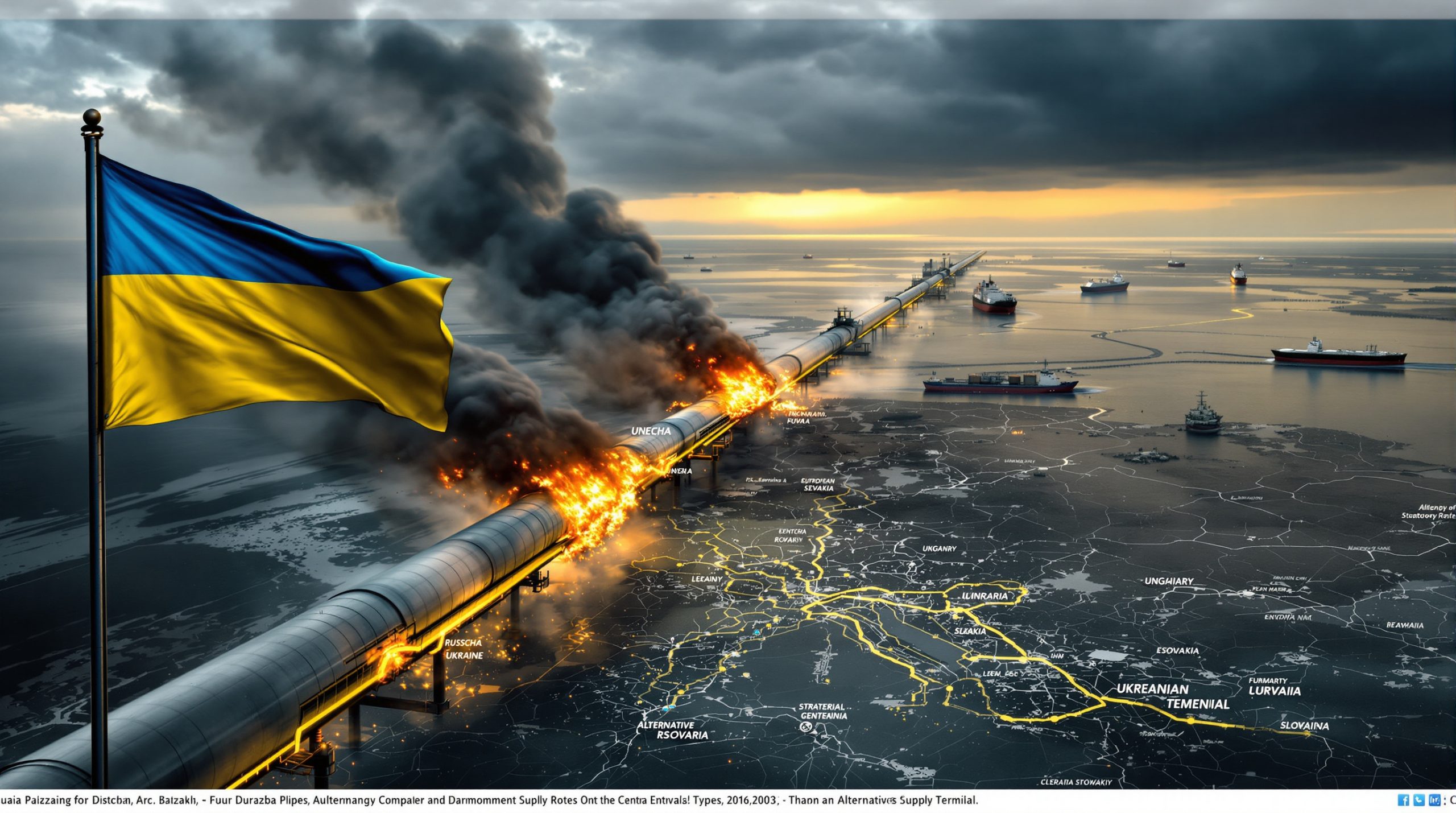Understanding Ukrainian Pipeline Strikes: Impact on European Oil Supply
The recent Ukrainian military strike on a key Russian oil pumping station has once again disrupted crude oil supplies to Hungary and Slovakia, marking the second such incident this week. This latest development has significant implications for European energy security and highlights the ongoing vulnerability of critical energy infrastructure in conflict zones.
Key Details of the Latest Pipeline Disruption
The Ukrainian armed forces targeted the Unecha pumping station located near the Russia-Ukraine border, effectively halting oil transportation through the Druzhba pipeline system. This strategic infrastructure serves as a vital conduit for Russian oil exports to Central European countries, particularly Hungary and Slovakia.
- Volume affected: Approximately 210,000 barrels per day of crude oil exports have been stranded
- Location: Unecha pumping station on the Russia-Ukraine border
- Pipeline system: Druzhba ("Friendship") pipeline
- Countries directly impacted: Hungary and Slovakia
According to reports from Reuters, this marks the second time within the same week that Ukrainian forces have bombed the Unecha pumping station, effectively stopping transportation along the Druzhba pipeline to Hungary and Slovakia.
What Is the Druzhba Pipeline System and Why Is It Important?
The Druzhba pipeline network represents one of Europe's most critical energy infrastructure systems, with a history dating back to the Soviet era. Understanding its importance helps contextualize the impact of these disruptions.
Historical Context and Technical Specifications
The Druzhba (meaning "Friendship" in Russian) pipeline system was constructed during the Soviet era to deliver oil from Russia to its Eastern European allies. As one of the world's longest pipeline networks, it serves as a crucial artery for energy supply to landlocked Central European nations.
Key characteristics of the Druzhba system include:
- Construction began in the 1960s as part of Soviet energy infrastructure expansion
- Total length exceeds 4,000 kilometers across multiple countries
- The network branches into northern and southern routes serving different European markets
- The southern branch supplies Hungary, Slovakia, and the Czech Republic
- The northern branch serves Poland and Germany
- Designed to transport various grades of crude oil from the Urals and Western Siberia
Current Geopolitical Significance
The pipeline has become increasingly politicized in recent years, particularly as European nations have sought to reduce dependence on Russian energy following the Russia-Ukraine conflict. Despite sanctions and diversification efforts, several Central European countries remain heavily reliant on this infrastructure for their energy needs.
The Druzhba pipeline represents:
- A physical manifestation of energy interdependence between Russia and Central Europe
- A strategic leverage point in regional geopolitics
- A challenging infrastructure to replace due to geographical and economic constraints
- A reminder of the complex legacy of Soviet-era infrastructure in modern European energy systems
How Are Affected Countries Responding to the Supply Disruption?
The repeated disruptions to the Druzhba pipeline have prompted varied responses from the affected nations, highlighting their different levels of energy security and alternative supply options.
Hungary's Response
Hungary, with its significant dependence on Russian oil imports, faces particular challenges from these disruptions. The country has limited immediate alternatives and maintains strategic petroleum reserves that can temporarily offset supply shortages.
Hungary's options include:
- Drawing from strategic reserves which typically provide approximately 90 days of normal consumption
- Seeking alternative supply via the Adria pipeline from Croatia, though capacity constraints exist
- Potentially requesting emergency assistance through European Union energy security mechanisms
- Negotiating for alternative delivery routes through neighboring countries
Hungary's geographic position as a landlocked nation makes diversification particularly challenging, creating a situation where pipeline disruptions have outsized impacts on energy security.
Slovakia's Position
Slovakia similarly relies heavily on Russian oil imports via the Druzhba system, though it has made some progress in diversification efforts in recent years.
Slovakia's response options include:
- Accessing strategic reserves maintained at EU-mandated levels
- Utilizing limited capacity for alternative sourcing via Austria and other neighboring countries
- Implementing temporary adjustments at the country's refineries to accommodate different crude grades
- Engaging with European energy security coordination mechanisms
Both countries face the challenge of balancing immediate energy security needs with longer-term strategic considerations regarding their dependence on Russian energy supplies.
What Are the Broader Implications for European Energy Security?
Short-Term Market Effects
Interestingly, despite the pipeline disruptions, market reaction has been relatively muted. According to recent oil price crash analysis, ICE Brent maintained a trading range of $65.80-$67.90 per barrel during the week of the strikes, with the period described as "one of the least eventful trading weeks of 2025."
This limited market response likely reflects:
- "Holiday-thinned liquidity" as noted in market reports
- Sufficient global supply cushions absorbing the disruption
- The relatively contained nature of the impact (210,000 barrels per day in a global market of roughly 100 million barrels per day)
- The expectation that alternative delivery mechanisms can be arranged
Nevertheless, regional impacts remain significant for the directly affected countries, even if global markets have shown limited reaction.
Long-Term Strategic Considerations
These recurring disruptions underscore several strategic challenges for European energy policy:
Accelerating Infrastructure Diversification
European nations have been working to reduce their dependence on Russian energy imports through various initiatives:
- Expansion of import terminals for non-Russian oil sources
- Enhancement of interconnection capacity between EU member states
- Development of alternative supply routes from the Mediterranean and Baltic regions
- Investment in storage capacity to improve resilience against supply shocks
The effectiveness of these measures varies significantly by country, with landlocked nations generally facing greater challenges in developing viable alternatives.
Geopolitical Dimensions
The targeting of energy infrastructure highlights how energy systems have become central to broader geopolitical conflicts:
- Energy infrastructure increasingly represents a strategic target in modern conflicts
- Cross-border pipeline systems demonstrate particular vulnerability to disruption
- Energy security has become intertwined with national defense planning
- Disruptions can exacerbate regional tensions and complicate diplomatic efforts
This evolution represents a significant challenge for international security frameworks that traditionally separate energy security from military security.
How Does This Compare to Previous Pipeline Disruptions?
While the current disruptions have unique characteristics, the Druzhba pipeline has experienced various interruptions throughout its operational history.
Historical Context of Pipeline Incidents
Previous disruptions have stemmed from a variety of causes, including technical failures, commercial disputes, and geopolitical tensions.
Notable past incidents include:
- Technical contamination issues that have periodically affected oil quality
- Transit fee disputes between Russia and transit countries
- Maintenance-related temporary shutdowns
- Weather-related operational challenges
- Political tensions affecting operational agreements
Distinguishing Factors of Current Disruptions
The current situation differs from many previous incidents in several key aspects:
- Direct military targeting rather than technical or commercial disputes
- Repeated incidents suggesting a potential pattern rather than isolated events
- Concurrent geopolitical tensions amplifying the impact and complicating resolution
- Reduced flexibility in the European energy system due to ongoing transition efforts
These factors create a more complex environment for resolving the disruptions and potentially indicate a new phase in energy infrastructure vulnerability.
What Are the Technical Challenges of Restoring Pipeline Operations?
Restoring pipeline operations after military strikes involves complex technical challenges that extend beyond normal maintenance procedures.
Engineering and Logistical Considerations
The repair process typically involves several critical phases:
Damage Assessment and Repair Requirements
- Initial safety securing of the affected area to prevent secondary hazards
- Comprehensive inspection of affected infrastructure components
- Procurement of specialized replacement parts (potentially complicated by sanctions)
- Safety certification before resumption of operations
- Environmental remediation if oil spillage occurred
The complexity of these repairs increases when the damage affects specialized equipment such as pumping stations, which contain numerous precision components and control systems.
Operational Restart Procedures
Restarting a pipeline after repairs is not as simple as "turning it back on." The process involves:
- Pressure testing of repaired sections to verify integrity
- Gradual reintroduction of flow to avoid pressure surges
- Quality monitoring of initial oil batches
- Coordination across multiple national jurisdictions
- Verification of communication and control systems
These technical challenges explain why even relatively localized damage can result in extended outages, particularly when the affected infrastructure is in a conflict zone where access may be restricted.
How Might This Affect Global Oil Markets?
Market Dynamics and Price Implications
While the immediate volume impact represents a small fraction of global oil trade, the psychological and regional effects can be significant. Recent trade war oil market impact analyses suggest these disruptions could compound existing pressures.
Supply Chain Adjustments
The disruption typically triggers several market adjustments:
- Rerouting of Russian exports to alternative markets, primarily in Asia
- Increased tanker demand for seaborne transportation alternatives
- Potential refinery adjustments to accommodate different crude qualities
- Storage drawdowns to compensate for pipeline disruptions
These adjustments create ripple effects throughout global energy markets, even if the direct volume impact is limited.
Price Effects Beyond Europe
Current market data suggests limited immediate price impact, with Brent crude maintaining a $65.80-$67.90/bbl range despite the disruptions. This stability likely reflects:
- Adequate global supply buffers
- Market focus on broader economic trends rather than regional disruptions
- Expectations for relatively quick resolution or workarounds
- Low trading volumes during the summer period reducing volatility
However, continued or expanded disruptions could eventually lead to:
- Modest global price support if disruption persists
- Widening regional price differentials, particularly for European refiners
- Potential knock-on effects for refined product markets, especially diesel
- Insurance and risk premium increases for energy infrastructure in conflict-adjacent regions
What Security Measures Protect Critical Energy Infrastructure?
Modern pipeline systems employ multiple layers of security to protect against various threats, though these measures face increasing challenges in conflict zones.
Physical and Cyber Protection Systems
Protection strategies typically include:
Physical Security Measures
- Perimeter monitoring and access control systems
- Regular security patrols of vulnerable sections
- Buried pipelines with minimal above-ground exposure
- Redundant control systems and emergency shutdown capabilities
- Hardened structures for critical components like pumping stations
These measures provide reasonable protection against criminal threats but have limitations against military actions or sophisticated attacks.
Cyber Security Considerations
Modern pipeline operations rely heavily on digital control systems, creating additional vulnerability vectors:
- Isolated operational technology networks to prevent unauthorized access
- Regular security audits and penetration testing
- Backup control systems with manual override capabilities
- International information sharing on emerging threats
- Advanced monitoring for anomalous system behavior
The integration of these physical and cyber security measures creates a defense-in-depth approach, though recent events demonstrate that significant vulnerabilities remain.
How Are International Organizations Responding?
Various international bodies play roles in addressing energy security challenges, though their effectiveness depends on member state cooperation.
Multilateral Coordination Efforts
International Energy Agency (IEA) Response
The IEA serves as a primary coordinator for energy security among developed economies:
- Monitoring of supply disruptions and market impacts
- Coordination of strategic petroleum reserve policies
- Technical assistance for affected member countries
- Analysis of long-term implications for energy security
- Facilitation of information sharing on mitigation strategies
The IEA's emergency response mechanisms provide a framework for coordinated action during significant disruptions.
European Union Mechanisms
The EU has developed several instruments to address energy security challenges:
- The Early Warning System for energy supply disruptions
- Coordination of cross-border assistance through the Energy Community
- Potential deployment of emergency oil sharing mechanisms
- Long-term policy responses through the Energy Union framework
- Regulatory harmonization to facilitate cross-border energy flows
These mechanisms aim to create a more resilient European energy system, though their effectiveness varies based on the specific circumstances of each disruption.
Broader Energy Market Context
The Druzhba pipeline disruptions occur against a backdrop of other significant developments in global energy markets:
- Recent U.S. Treasury Department sanctions affecting 13 commercial entities in Hong Kong, China, and the UAE related to Iran
- Chinese private oil firm Concord Resources agreeing to invest more than $1 billion in Venezuelan oilfields, aiming to produce 60,000 barrels per day by the end of next year
- Ongoing energy transition efforts affecting investment patterns in fossil fuel infrastructure
- Shifting trade patterns as Russia increasingly redirects energy exports to Asian markets
Additionally, recent policy changes including the Alaska oil policy shift and discussions about tariffs and market effects further complicate the global energy landscape.
FAQ: Pipeline Disruptions and European Energy Security
What alternatives do affected countries have for oil supplies?
Affected countries have several alternatives, though each comes with limitations:
- Strategic petroleum reserves: Most European countries maintain emergency stocks equivalent to 90 days of imports
- Alternative pipeline routes: Limited capacity exists via the Adria pipeline from Croatia and other regional interconnections
- Seaborne imports: Terminals on the Adriatic and Baltic coasts can receive tanker shipments, though inland transportation may present bottlenecks
- Refined product imports: Finished fuels can be imported via rail, road, and barge to supplement reduced crude processing
These alternatives typically involve higher costs and logistical challenges compared to normal pipeline operations.
How long can countries operate without pipeline supplies?
Most affected countries can manage without pipeline supplies for several months through a combination of:
- Strategic petroleum reserves (typically 90+ days of normal consumption)
- Commercial inventories at refineries and storage facilities
- Alternative import arrangements via other routes
- Demand management measures if necessary
The exact duration depends on factors including the season, economic activity levels, and availability of alternative supplies.
What are the environmental risks of pipeline disruptions?
Pipeline disruptions can pose several environmental challenges:
- Potential oil spills if pipeline integrity is compromised during attacks
- Increased emissions from alternative transportation methods (trucks, rail)
- Soil and groundwater contamination requiring remediation
- Ecological impacts in sensitive areas near damaged infrastructure
Properly managed shutdowns minimize these risks, but unexpected disruptions increase the potential for environmental damage.
How might this affect consumer fuel prices?
The impact on consumer fuel prices depends on several factors:
- Duration of the disruption
- Availability and cost of alternative supplies
- Government intervention through tax adjustments or price controls
- Refinery economics and competitive dynamics in local markets
Typically, short-term disruptions have limited consumer impact due to existing inventories and hedging practices, while prolonged issues may eventually lead to price increases at the pump, particularly in directly affected countries.
The Future of European Energy Security
The recurring disruptions to the Druzhba pipeline system highlight the ongoing vulnerabilities in Europe's energy infrastructure and the complex interplay between geopolitics and energy security. As European nations continue their energy transition journeys, building resilience against such disruptions will remain a critical priority, potentially accelerated by recent OPEC production boost decisions.
Key takeaways include:
- The need for accelerated diversification of supply routes and sources
- Importance of robust emergency response mechanisms
- Growing recognition of energy infrastructure as a security concern
- Potential for regional cooperation to enhance collective energy security
As the situation evolves, affected countries will likely implement both immediate mitigation measures and longer-term structural changes to their energy systems, potentially accelerating Europe's broader energy transition goals.
The Ukrainian pipeline strikes represent not just a temporary disruption but a reminder of the strategic significance of energy infrastructure in modern geopolitical conflicts. How Europe responds to these challenges will shape its energy security landscape for decades to come.
Looking for Instant Insights on Major Mineral Discoveries?
Discover how to gain a competitive edge in the ASX mining sector with Discovery Alert's proprietary Discovery IQ model, delivering real-time notifications on significant mineral discoveries the moment they're announced. Visit the Discovery Alert discoveries page to see how historic discoveries have generated substantial returns for informed investors.




